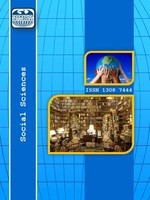A CASE STUDY FOR DEVELOPMENT AND VALIDATION OF A SAFETY CLIMATE SCALE FOR SHIPBUILDING INDUSTRY
Safety Climate, Occupational Safety, Climate Shipbuilding Industry, AMOS Statistics Program
___
- • Basha, S.A. and Maiti, J., (2013). Relationships of Demographic Factors, Job Risk Perception and Work Injury in a Steel Plant in India, Safety Science, 51, 374-381.
- • Bertram, D., (2009). Likert Scales. Topic Report, the Faculty of Mathematics, University of Belgrade, Serbia.
- • Clark, L.A. and Watson, D., (1995). Constructing Validity: Basic Issues in Objective Scale Development. Psychological Assessment, Vol 7(3), 309-319.
- • Clarke, S.G., (2006). The Relationship between Safety Climate and Safety Performance: A Metanalytic Review. Journal of Occupational Health Psychology, 11(4), 315-327.
- • Cox, S. and Flin, R., (1998). Safety Culture: Philosopher’s Stone or Man of Straw? Work & Stress, 12(3), 189-201.
- • Flin, R., Mearns, K., O’Connor, P., and Bryden, R., (2000). Measuring Safety Climate: identifying the common features. Safety Science, 34:177-192.
- • Ghahramani, A. and Khalkhali, H.R., (2015). Development and Validation of a Safety Climate Scale for Manufacturing Industry. Safety and Health at Work 6, 97-113.
- • Glendon, A.I. and Litherland, D.K., (2001). Safety Climate Factors, Group Differences And Safety Behavior in Road Construction. Safety Science, 39, 157-188.
- • Grote, G. and Künzler C., (2000). Diagnosis of Safety Culture in Safety Management Audits, Safety Science, 34:131-50.
- • Guldenmund, F.W., (2000). The Nature of Safety Culture: a Review of Theory And Research. Safety Science, 34, 215-257.
- • Hair, J.F., Black, J.R., W.C., Babin, B.J., Anderson, R.E., and Tatham, R.L., (2006). Multivariate Data Analysis, Prentice Hall, 6. Baskı, New Jersey.
- • Harvey, J., Erdos, G., Bolam, H., Cox, M.A.A., Kennedy, J.N.P., and Gregory, D.T., (2002). An Analysis of Safety Culture attitudes in a Highly Regulated Environment. Work & Stress, 16(1), 18-36.
- • Hetherington, C., Flin, R., and Mearns, K., (2006). Safety in Shipping: The Human Element. Journal of Safety Research 37, 401–411.
- • Hofmann, D.A., Jacobs, R., and Landy, F., (1995). High Reliability Process Industries: Individual, Micro and Macro Organizational Influences on Safety Performance, Journal of Safety Research, 26:131-49.
- • Lawshe, C.H., (1975). A Quantitative Approach to Content Validity. Personnel Psychology, 28, 563–575.
- • Lin, S.H., Tang, W.J., Miao, J.Y., Wang, Z.M., and Wang, P.X., (2008). Safety Climate Measurement at Workplace in China: A validity and reliability assessment. Safety Science 46, 1037–1046.
- • Lu, C.S. and Yang, C.S., (2011). Safety Climate and Safety behavior in the Passenger Ferry Context. Accident Analysis & Prevention 43, 329-341.
- • Mearns, K.J. and Flin, R., (1999). Assessing the State of Organization Safety–Culture or Climate? Current Psychology 18 (1), 5–17.
- • Neal, A. and Griffin, M.A., (2004). Safety Climate and Safety at Work. In: Barling, J., Frone, M.R. (Eds.), The Psychology of Workplace Safety. American Psychological Association, Washington, DC, pp:15–34.
- • Nielsen, M.B., Eid, J., Hystad, S.W., Sætrevik, B., and Saus, E.R., (2013). A brief Safety Climate Inventory for Petro-Maritime Organizations. Safety Science 58, 81–88.
- • Rundmo, T. and Hale, A., (2003). Managers Attitudes towards Safety and Accident Prevention, Safety Science, 41:557-74.
- • Schumacker, R.E. and Lomax, R.G., (2004). A Beginner’s Guide to Structural Equation Modeling, Lawrence Erlbaum Associates, 2. Press, Mahwah, NJ.
- • Veneziano, L. and Hooper, J., (1997). A Method for Quantifying Content Validity of Health-Related Questionnaires, American Journal of Health Behavior, 21(1):67-70.
- • Vinodkumar, M.N. and Bhasi, M., (2009). Safety Climate Factors and its Relationship with Accidents and Personal Attributes in the Chemical Industry. Safety Science 47, 659–667.
- • Wiegmann, D.A., Zhang, H., von Thaden, T., Sharma, G., and Mitchell, A., (2002). A Synthesis of Safety Culture and Safety Climate Research. Aviation Research Lab, Institute of Aviation, UIUC. Technical Report ARL-02e3/FAA-02-2.
- • Williamson, A.M., Feyer, A.M., Cairns, D., and Biancotti, D., (1997). The Development of a Measure of Safety Climate: The role of Safety Perceptions and Attitudes. Safety Science, 25(1-3), 15-27.
- • Zohar, D., (1980). Safety Climate in Industrial Organizations: Theoretical and Applied Implications. Journal of Applied Psychology, 65, 96-102.
- Başlangıç: 2009
- Yayıncı: Cevdet Emin EKİNCİ
PEYZAJ MİMARLIĞI EĞİTİMİNDE PROJE TASARIM SÜRECİ: TRABZON “KARAGÖZ MEYDANI” ÇEVRE TASARIM PROJELERİ
Elif BAYRAMOĞLU, Umut BÜYÜKKURT, Nazlı Mine YURDAKUL
GENÇLERİN AÇIK MEKÂN KULLANIMLARI: KTÜ KANUNİ KAMPÜSÜ ÖRNEĞİ
Tugba DÜZENLİ, Emine TARAKÇI EREN, Elif Merve ALPAK
A CASE STUDY FOR DEVELOPMENT AND VALIDATION OF A SAFETY CLIMATE SCALE FOR SHIPBUILDING INDUSTRY
Leyla Tavacıoğlu, Taç Umut, Pelin Bolat, Uluç Mörek
MASCHINELLE ÜBERSETZUNG ANSTELLE VON HUMANEN ÜBERSETZERN ZWISCHEN MASCHINE UND MENSCH
